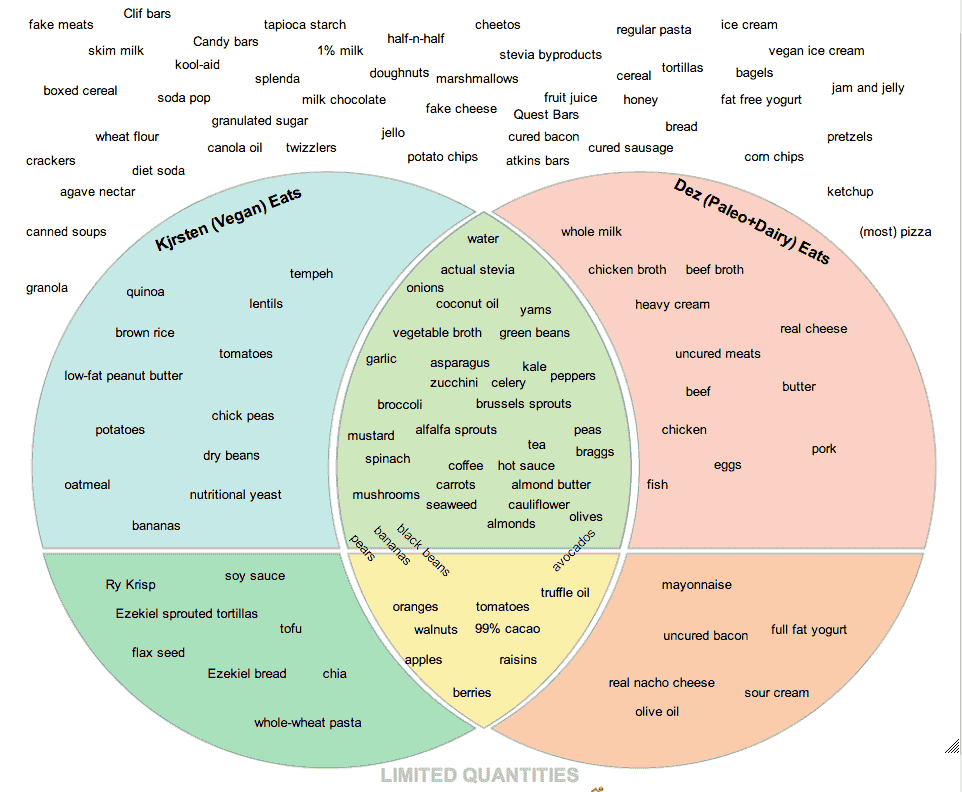Editor’s Note: This website is not designed to, and should not be construed to, provide medical advice, professional diagnosis, opinion or treatment to you or any other individual, and is not intended as a substitute for medical or professional care and treatment. For serious.
~
Finding Common Ground Between Paleo and Vegan
Food is medicine, and as a doctor I tell people about the most nutrient dense foods to prevent, treat and even reverse chronic disease. At the same time, what to eat can become complicated, confusing and contentious.
Studies show vegan diets help with weight loss, reverse diabetes and lower cholesterol. So do Paleo diets. The conversation can quickly become heated, with each camp dogmatically adhering to their diet and cherry-picking studies validating their point of view. After reading dozens of studies on vegan and Paleo diets, even I can become confused.
After researching nutrition for 30 years and analyzing thousands of scientific papers and treating tens of thousands of patients with food, I’ve reached a compromise.
I vote for becoming a Pegan or Paleo-Vegan, which combines the strengths of both diets and focuses on real, whole, fresh, sustainably raised food.
We’re Not so Different After All
Paleo and vegan camps might appear to agree on little, but both diets share some common foundations. Both are:
1. Very low in glycemic load. Low in sugar, flour and refined carbohydrates.
2. High in vegetables and fruits. When we eat a variety of fruits and vegetables—especially those dark in color—we consume a higher amount of phytonutrients, protecting us against most diseases.
3. Low in pesticides, antibiotics and hormones and low or no GMO foods.
4. No chemicals, additives, preservatives, dyes, MSG, artificial sweeteners and other “Franken Chemicals.”
5. Higher in good quality fats from olive oil, nuts, seeds and avocados.
6. Adequate protein for appetite control and muscle synthesis.
7. Organic, local, fresh foods form the basis of our diet.
8. If we consume animal products, they should be sustainably raised or grass fed.
9. If we eat fish, we choose low-mercury and low toxin-containing fish such as sardines, herring and anchovies or other small fish. Avoid high-mercury load fish like tuna.
10. Avoid dairy. While some can tolerate it, for most it contributes to obesity, diabetes, heart disease and cancer, and may increase (not decrease) the risk of osteoporosis.
Acknowledging our Disagreements
Here’s where Paleo and vegan diets don’t align:
1. Grains. For millions of Americans gluten creates inflammation, autoimmunity, digestive disorders and even obesity. We started consuming grains recently in our evolutionary history and they can be part of a healthy diet, but not in unlimited amounts.
2. Beans. Beans are a great source of fiber, protein and minerals, but they create digestive problems for some. If we are diabetic, excessive amounts of beans can trigger spikes in blood sugar. Up to one cup a day should be fine for most people. Some Paleo folks are concerned that beans contain lectins, which create inflammation, and phytates, which impair mineral absorption.
3. All meat is not created equally. Eating sustainably raised, clean meat, poultry and lamb can be a part of a healthy diet. But eating meat also puts pressure on the planet, including more water use, more climate change and more energy inputs. Eat meat as a side dish or condiment, and only consume grass-fed and sustainably raised.
4. Eggs. Eggs have been exonerated and don’t have any impact on cholesterol and are not associated with increased risk of heart disease. They provide a great low-cost source of vital nutrients and protein.
5. Fish. Choose small, omega-3 fat-rich fish such as sardines or wild salmon to minimize mercury. If we are vegan, we need omega-3 fats, and not just alpha-linolenic acid (ALA) found in plants. We need pre-formed docosahexaenoic acid (DHA), which is what most of our brain is made from. Look for an algae-derived DHA supplement. Everyone needs Vitamin D3. For vegans, vitamin B12 is also critical.
Finding that Middle Ground
We don’t need to agree on everything, but I hope I’ve shown that Paleo and vegan camps have some commonalities.
Finding the strengths of both diets and becoming a Pegan means we focus less on how much we eat and more on the quality of what we eat.
This is what a Pegan diet looks like:
1. Eat a low-glycemic load. We avoid sugary, processed foods with a high glycemic load and focus instead on protein, fat and healthy carbohydrates.
2. Eat the right fats. Rather than nutrient-poor vegetable oil and other damaged fats, we focus on omega-3 fats, nuts, coconut, avocados, and yes, even saturated fat from grass-fed or sustainably raised animals.
3. Eat mostly plants. Plants should form 75 percent of our diet and our plate.
4. Focus on nuts and seeds. Rich in protein, minerals, and good fats, nuts and seeds lower the risk of heart disease and diabetes.
5. Avoid dairy. Dairy is great for growing calves into cows, but not for humans. Try organic goat or sheep products, but only as a treat.
6. Avoid gluten. Most is from Franken Wheat, so look for heirloom wheat (Einkorn). If we are not gluten sensitive, consider gluten an occasional treat.
7. Eat gluten-free whole grains sparingly. They still raise blood sugar and can trigger autoimmunity.
8. Eat beans sparingly. Lentils are best. Stay away from big starchy beans.
9. Eat meat or animal products as a condiment, not a main course.
10. Think of sugar as an occasional treat. Use it sparingly or not at all.
What one strategy would you add to this list to find a compromise between Paleo and vegan? Share your experience below or on my Facebook fan page.
~
References
Frassetto LA, et al. Metabolic and physiologic improvements from consuming a paleolithic, hunter-gatherer type diet. Eur J Clin Nutr. 2009 Aug;63(8):947-55. doi: 10.1038/ejcn.2009.4. Epub 2009 Feb 11.
Rong Y, et al. Egg consumption and risk of coronary heart disease and stroke: dose-response meta-analysis of prospective cohort studies. BMJ. 2013 Jan 7;346:e8539. doi: 10.1136/bmj.e8539.
Torre M, et al. Effects of dietary fiber and phytic acid on mineral availability. Crit Rev Food Sci Nutr. 1991;30(1):1-22.
Turner-McGrievy GM, et al. A two-year randomized weight loss trial comparing a vegan diet to a more moderate low-fat diet. Obesity (Silver Spring). 2007 Sep;15(9):2276-81.
http://www.ncbi.nlm.nih.gov/pmc/articles/PMC1115436//
~
Relephant:
Skip the Dieting & Become a Qualitarian.
This Diet has Cured More of my Patients than any other Method I’ve Tried.
~
Author: Mark Hyman
Editor: Rachel Nussbaum
Photo: Google Images for Reuse












Read 6 comments and reply